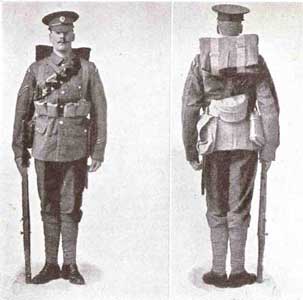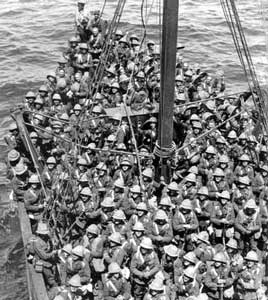A Replacement for the Valise Equipment, Pattern 1888
 The 2nd Boer War is over, and the limitations and deficiencies of the Valise Equipment, Pattern 1888 are well known. Everyone agrees that a replacement is needed and the Mills Woven Cartridge Belt Company of London, England, is eager to step in with its latest web equipment. The War Office, though, has other ideas, and when the new equipment is chosen, it is still a leather equipment, rather than cotton webbing. This new equipment was the Bandolier Equipment, Pattern 1903.
The 2nd Boer War is over, and the limitations and deficiencies of the Valise Equipment, Pattern 1888 are well known. Everyone agrees that a replacement is needed and the Mills Woven Cartridge Belt Company of London, England, is eager to step in with its latest web equipment. The War Office, though, has other ideas, and when the new equipment is chosen, it is still a leather equipment, rather than cotton webbing. This new equipment was the Bandolier Equipment, Pattern 1903.
According to Albert Lethern, author of the M.E.Co.. Golden Jubilee book, the choice of leather over Mills’ web was made because of a misunderstanding by the General Staff . During the war, the Mills Company had produced cheap, "single use" ammunition bandoliers made of very light woven webbing. The intention was solely for ammunition re-supply, cartridge pouches being re-filled and the bandolier discarded. In practice, these bandoliers were issued for wear by the growing numbers of Mounted Infantry then being deployed.. Because of their very light construction, the cartridge sleeves stretched and the reloaded cartridges enthusiastically flung themselves in all directions. Denys Reitz, in his book Commando, describes how he and his comrades followed the columns of soldiers. Along the route and wherever the Brits had halted, plenty of lost ammunition could be picked up by the Boers, who were using captured Lee-Metford rifles This misuse, from the Mills Company's viewpoint, prejudiced field commanders against all webbing. Amongst the "hide bound officialdom" (to use Lethern's oh-so-appropriate phrase), who gave damning reports against web, were Generals French, Plumer, Baden-Powell, Lord Roberts, and Lord Kitchener himself.
This problem was known at the time and instructions were issued to modify the heavier web waistbelts, which were actually being used as bandoliers. Leather (sometimes fabric) flaps were stitched along the top edge, secured to brass studs. M.W.C.B.Co. also re-designed the heavier bandoliers to have a continuous web flap. However, mud had been thrown and it had stuck, at least in the minds of senior officers. The damage had been done.
 What does seem clear is that the Pattern 1903 equipment wasn't very good, at least as an infantry equipment. It had all of the old problems of Slade-Wallace: it was uncomfortable to wear, time consuming to put on and off, and the items being carried were not easily accessible in the field. The period between the Boer War and 1914 was little-photographed and, within five years, the Regular Army were re-equipping with Pattern 1908 Web Equipment. Bandolier Equipment was used to upgrade units of the Territorial Force, all of whom had been previously equipped with leather equipment of earlier patterns. Judging from contemporary photographs of the Great War, Pattern 1903 does not seem to have been terribly popular in the field. Probably the last widespread use of Bandolier Equipment was by a Territorial unit, the 1st/5th Lancashire Fusiliers, who landed in Gallipoli, as shown in the photograph on the right. The Pattern did continue in use in the Great War, with Colonial units, campaigning in Africa and also many of the Indian Army units on the Western Front.
What does seem clear is that the Pattern 1903 equipment wasn't very good, at least as an infantry equipment. It had all of the old problems of Slade-Wallace: it was uncomfortable to wear, time consuming to put on and off, and the items being carried were not easily accessible in the field. The period between the Boer War and 1914 was little-photographed and, within five years, the Regular Army were re-equipping with Pattern 1908 Web Equipment. Bandolier Equipment was used to upgrade units of the Territorial Force, all of whom had been previously equipped with leather equipment of earlier patterns. Judging from contemporary photographs of the Great War, Pattern 1903 does not seem to have been terribly popular in the field. Probably the last widespread use of Bandolier Equipment was by a Territorial unit, the 1st/5th Lancashire Fusiliers, who landed in Gallipoli, as shown in the photograph on the right. The Pattern did continue in use in the Great War, with Colonial units, campaigning in Africa and also many of the Indian Army units on the Western Front.
 For use by the cavalry, though, it seems to have been much more acceptable. M.E.Co.'s cavalry webbing of 1911 underwent military trials, and by 1914 General Sir John French had recommended it for adoption. The onset of war, though, prevented that from happening, and Pattern 1903 continued in use as a cavalry and second line equipment. Although the entire equipment does not seem to have been overly popular, the Bandoliers themselves, especially the five pocket version, are commonly seen in period photographs. They had become the distinguishing mark of the mounted soldier. Thus Drivers of the Corps of Royal Engineers also wore Bandoliers, but of the 50-round type, whereas cavalrymen all wore the 90-round version. In 1922, Ireland separated into the Irish Free State and Northern Ireland, or Ulster. Many of the 50-round Bandoliers were dyed black and issued to the newly formed Royal Ulster Constabulary, along with other items from the Pattern. The 50-round Bandolier was produced as late as WWII in South Africa.
For use by the cavalry, though, it seems to have been much more acceptable. M.E.Co.'s cavalry webbing of 1911 underwent military trials, and by 1914 General Sir John French had recommended it for adoption. The onset of war, though, prevented that from happening, and Pattern 1903 continued in use as a cavalry and second line equipment. Although the entire equipment does not seem to have been overly popular, the Bandoliers themselves, especially the five pocket version, are commonly seen in period photographs. They had become the distinguishing mark of the mounted soldier. Thus Drivers of the Corps of Royal Engineers also wore Bandoliers, but of the 50-round type, whereas cavalrymen all wore the 90-round version. In 1922, Ireland separated into the Irish Free State and Northern Ireland, or Ulster. Many of the 50-round Bandoliers were dyed black and issued to the newly formed Royal Ulster Constabulary, along with other items from the Pattern. The 50-round Bandolier was produced as late as WWII in South Africa.